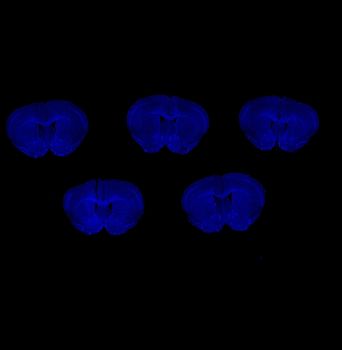
Neuronal circuits of reward and aversion
Since the moment we wake up, we are continuously flooded with sensory information of variable relevance. Therefore, our brains evolved to filter information, and focus on relevant stimuli that are associated with an emotionally significant experience. A stimulus that is inherently appetitive/rewarding (positive valence) triggers approach; whereas a stimulus that is aversive (negative valence) induces avoidance. Different regions of the limbic system represent valence, including the nucleus accumbens, amygdala, ventral tegmental area, amongst others.
Our team is focused in understanding how our brain encodes valence, and how this information is conveyed into motivated behaviors. We are particularly interested in the nucleus accumbens circuitry, crucial for rewarding/aversive learning and motivation.
We use a combination of tools including behavioral evaluation, optogenetics, electrophysiology, pharmacology and live imaging with genetically-encoded sensors in rodents to understand how reward and aversion are encoded in the nucleus accumbens circuitry. We are performing these studies in physiological conditions but also in rodent models of neurodevelopmental challenges such as prenatal stress. Ultimately, by unveiling the neurobiological underpinnings of motivated behavior, one can contribute for the mechanistic interpretation of neuropsychiatric disorders such as depression and addiction.
Funding Agency
ERC, La Caixa Foundation, FCT
Project Reference




Project Members


João Bessa

João Oliveira

Luisa Pinto

Nuno Sousa

Bárbara Coimbra

Carina Soares-Cunha

Claire Terrier

Leandro A. Aguiar

Tawan T. A. Carvalho

Ana Verónica Domingues

Gisela Armada

Natacha Vieitas-Gaspar

Raquel Correia

Catarina Deseyve

Ricardo Bastos-Gonçalves

Marcelina Węzik

Rita Gaspar
Main Project Outcomes
S. Queirós, “Right ventricular segmentation in multi-view cardiac MRI using a unified U-net model”, in E. Puyol Antón et al. (eds) Statistical Atlases and Computational Models of the Heart. Multi-Disease, Multi-View, and Multi-Center Right Ventricular Segmentation in Cardiac MRI Challenge. STACOM 2021. Lecture Notes in Computer Science, vol 13131, pp. 287-295, Springer, Cham, 2022.
“Best Paper Award in the M&Ms-2 Challenge”, by M&Ms2 Challenge organizers and the Medical Image Computing and Computer Assisted Intervention (MICCAI) Society.
Main Project Outcomes
1. Soares-Cunha (…), Rodrigues AJ. Distinct role of nucleus accumbens D2-MSN projections to ventral pallidum in different phases of motivated behavior. Cell Reports (2022)
2. Coimbra (…), Rodrigues AJ. Laterodorsal tegmentum–ventral tegmental area projections encode positive reinforcement signals. Journal of Neuroscience Research (2021)
3. Coimbra B, Soares-Cunha C, Vasconcelos NAP, Sousa N, Rodrigues AJ. Role of laterodorsal tegmentum projections to nucleus accumbens in reward-related behaviors”. Nature Communications (2019)
4. Soares-Cunha C, Vasconcelos NAP, Coimbra B, Domingues AV, Silva J, Loureiro-Campos E, Gaspar R, Sotiropoulos I, Sousa N, Rodrigues AJ. “Nucleus accumbens medium spiny neurons subtypes signal both reward and aversion”. Molecular Psychiatry (2019)
5. Soares-Cunha C, Coimbra B, Domingues AV, Vasconcelos N, Sousa N, Rodrigues AJ. “Nucleus accumbens microcircuit underlying D2-MSN-driven increase in motivation”. eNeuro (2018)
6. Vasconcelos N, Soares-Cunha C, Rodrigues AJ, Ribeiro S, Sousa N. “Coupled variability in primary sensory areas and the hippocampus during spontaneous activity”. Scientific Rep (2017)
7. Soares-Cunha C, Coimbra B, Pereira A, Pinto L, Costa P, Sousa N, Rodrigues AJ. “Activation of D2 dopamine receptor-expressing neurons in the nucleus accumbens increases motivation. Nature Communications”. (2016)
8. Soares-Cunha C, Coimbra B, Sousa N, Rodrigues AJ. “Reappraising striatal D1- and D2-neurons in reward and aversion”. Neuroscience & Biobehavioral Reviews. (2016)
9. Science outreach in national media – Researchers win a millionaire scholarship to study the brain; https://www.rtp.pt/noticias/pais/equipa-da-universidade-do-minho-garante-bolsa-de-2-milhoes-de-euros_v1297263
10. Science outreach in local media – Medalha de Honra L’Oréal Portugal para as Mulheres na Ciência – Carina Soares-Cunha; https://www.youtube.com/watch?v=Kjw00GBQzfY



Contact us
Phone: +351 253 604 967
Fax: +351 253 604 809
Email: icvs.sec@med.uminho.pt
Address
Life and Health Sciences
Research Institute (ICVS)
School of Medicine,
University of Minho,
Campus de Gualtar
4710-057 Braga
Portugal

Copyright ©2022 ICVS. All Rights Reserved



Copyright ©2022 ICVS. All Rights Reserved
Address
Life and Health Sciences
Research Institute (ICVS)
School of Medicine,
University of Minho,
Campus de Gualtar
4710-057 Braga
Portugal



Copyright ©2022 ICVS. All Rights Reserved
Address
Life and Health Sciences
Research Institute (ICVS)
School of Medicine,
University of Minho,
Campus de Gualtar
4710-057 Braga
Portugal

